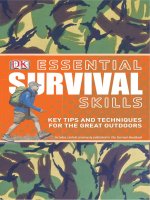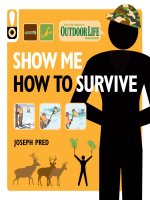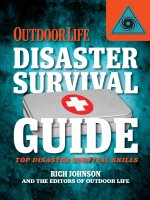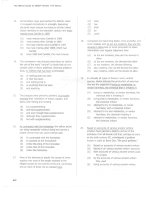Outdoor Life - Disaster Survival Guide - For Disaster Survival Skills
Bạn đang xem bản rút gọn của tài liệu. Xem và tải ngay bản đầy đủ của tài liệu tại đây (4.99 MB, 15 trang )
DISASTER
SURVIVAL
GUIDE
TOP DISASTER SURVIVAL SKILLS
RICH JOHNSON
AND THE EDITORS OF OUTDOOR LIFE
TOP SKILLS FOR DISASTER PREP
RICH JOHNSON
WITH ROBERT F. JAMES
SURVIVAL
GUIDE
DISASTER
KNOW WHAT’S HAPPENING Problems can
arise when you’re not paying attention. If you
remain cognizant of your surroundings, then you
can respond appropriately.
PRIORITIZE Once you know what kind of fix
you’re in, decide what your most pressing need
is. If your buddy has a bullet in his leg, your
most pressing need isn’t hunting dinner.
DEVISE A PLAN Now that you know what
needs to be done first (and next, and then next),
decide how to attack the problem. Weigh your
options, then make smart decisions that will
give you the desired result.
GO TO WORK The time has come for the rubber
to meet the road. As you work on resolving each
challenge, continually assess the situation.
Decide if what you’re doing is working, or if you
need to change strategies.
Remember, you’re tr ying to survive, and that’s a
worthy goal if ever there was one. Give it your all
and good luck!
SURVIVAL STRATEGIES
011
Set a Bone
If you’ve ever heard the grim sound of
a bone breaking, you know just how
dire this situation can be. Getting to a
hospital is always the best recourse,
but if you can’t, setting the bone in
place might be the only way to save
the arm or leg. Here’s how to do it.
ASSESS THE BREAK Many breaks
don’t need setting, but a few, such
as transverse, oblique, or impacted
fractures, might. If a bone is actually
protruding from the skin, don’t try to
set it. Just immobilize it.
CHECK FOR BLOOD FLOW Press
on the skin below the fracture site.
The skin should turn white and then
quickly return to pink. Pale or bluish
skin, numbness, tingling, or the lack
of a pulse in the limb indicate a loss of
circulation, and you will need to set
the bone to restore circulation.
PUT IT IN PLACE To reduce
swelling, pain, and damage to tissues
caused by lack of circulation, realign
Transverse
Hairline
Oblique
Spiral
Greenstick
Segmental
Compression
Comminuted
STEP THREE
Slide the unfolded
splint material
beneath the
limb, and pad it
for comfort and
stability.
STEP FOUR
Fold the splint
around the leg, securing it with elastic,
gauze, or other material. The splint
should be just tight enough to prevent
the bone from shifting, but not so tight
the limb into a normal resting position
by pulling in opposite directions on both
sides of the break.
that it impedes circulation. If the break
involves a joint, secure the splint both
above and below it for extra stability.
Avulsion Torus Impacted Linear
030
Home sweet home isn’t so sweet when it’s full of mucky
water—especially when you are low on supplies and don’t
know if assistance is on the way. Since your furnishings aren’t
helping you much (who needs a hutch full of china plates if
there’s no food to eat off them?), get creative and turn one of
them into a life raft. You can simply float away on one of these
larger items, or secure several together with rope.
CHECKLIST
Make a Life Raft from
Household Items
RICH SAYS
“Unless you’re a fish who loves
contaminated filth, you’d better get
to high ground.”
� Mattress
� Air compression tank
� Dining room table
� Lawn chair cushions
� Plastic trash cans
� Ice chest
� Children’s float toys
� Plastic swimming pool
� Fiberglass bathtub
� Spare tire
� Large plastic tub
� Collection of smaller
plastic jugs and bottles
held together under a
platform of boards
043Survive a Wildfire
During a wildfire, the most dangerous
places to be are uphill or downwind
from the flames. Speaking of wind, if
it’s blowing toward the fire, run into the
wind. But if it’s behind the fire, you need
to move away even faster —that fire will
be coming on quick.
If told to evacuate, do so. But if you’re
trapped at home, stay inside where the
structure will protect you. Move to a
central room, away from the exterior
walls of your house. Close the doors in
order to cut down on air circulation,
which can feed the flames.
If you’re caught in the open, move to an
area that has already burned over. Avoid
canyons and other natural chimneys.
Get into a river or lake, if possible. Look
for breaks in the trees, which could
mean breaks in the firestorm. If you’re
near a road, lie facedown along the
road or in a ditch or depression on the
uphill side. Cover up with anything that
provides a shield against the heat.
046
047
Volcanic ash isn’t soft and fluffy—as
if the mountain had been in a pillow
fight. Nope, ash is composed of tiny
jagged pieces of rock and glass. It’s
hard, abrasive, and corrosive. Because it
destroys engines when it’s sucked into
the intake, volcanic ash halts air travel
and hampers ground transportation for
hundreds of miles around an eruption.
But if you live close to an active volcano,
your problems might be much more
immediate than travel delays.
TAKE COVER During an ash fall,
stay inside—especially if you have
a respiratory ailment. Close doors,
windows, vents, and chimney flues.
Monitor radio and TV broadcasts about
the situation.
WEAR LAYERS If you have to go
outside, wear long sleeves and pants.
Breathe through a dust mask, or hold a
damp cloth over your nose and mouth.
Use goggles or wear eyeglasses instead
of contact lenses to avoid trapping dust
and ash beneath them.
Cope
with Ash
Even if you’re pretty sure it has cooled
and hardened, it’s better to detour
around a lava field—because if you’re
wrong, you’re toast. Literally.
TREAD LIGHTLY If you must cross,
try to ensure that the lava has totally
hardened. You can’t always tell from
looking, because molten lava might
be flowing below a thin crust that can
fool you. As you move forward, probe
the ground ahead of you with a stick.
DO A SNIFF TEST Pay attention
to air quality. Sulfur dioxide gases
indicate flowing lava beneath you.
This gives you two reasons to get
away: Not only is the ground unstable,
but that gas is toxic as well.
HEED YOUR FEET If the soles of
your boots start to melt, the flow is
definitely too hot to walk on. And if
the ground feels at all mushy, that
means it’s too unstable to cross.
Assess a Lava Field
START SHOVELING Ash accumulations
can pile deep on roofs, requiring shovel
work to prevent them from collapsing.
Make sure you clear rain gutters as well.
BE CAREFUL ON THE ROAD Prevent
engine damage by avoiding driving. If
you must, drive slowly and bear in mind
that some roads may be impassable.
052
053
You probably know the drill: If you’re
inside a building when an earthquake
hits, stay there. If you’re outside, get into
a clearing. But what if you’re driving?
STOP FOR THE SHAKING There are
two hazards if an earthquake strikes
Ride Out a Quake in a Car
See a clear path to safety? Then get yourself out. But when
the walls come down, people inside usually can’t save
themselves. Let rescuers know where you are by tapping
on a pipe or wall. Use a whistle if you have one. To avoid
inhaling dust, cover your mouth and nose with a cloth, and
use your voice only as a last resort. Don’t light a match or
lighter to see where you are, as there could be a gas leak.
Survive Being Trapped
Under Debris
when you’re driving: other drivers
and falling objects. Pull over in an area
free of things that might fall on your
car, such as telephone poles, street
lights, and, yes, even overpasses. The
more open the area, the safer it is.
DEAL WITH INFRASTRUCTURE If
you’re on a bridge, take the next exit
off it. And if you’re stuck under that
overpass, get out of your car and lie
flat beside it. Should the structure
collapse, it will crush your car, but not
to the ground—which will hopefully
leave a safe zone immediately around
your vehicle.
HEAD HOME There is always a
chance of aftershocks, so don’t hurry
off. Listen to the radio for updates
that may affect your route, and expect
accidents and damage.
066
Ride Out an
Avalanche
Caught in an avalanche? Well, that’s plain bad luck. Use skiing (or even surfing)
moves to try to ride on top of the snow, and attempt to maneuver toward the edge
of the slide. If the snow is moving slowly, try to catch hold of a tree without getting
creamed by it. In a fast-moving slide that knocks you off your feet, swim in the snow
and try to avoid hitting stationary obstacles.
RICH SAYS
“The best solution in a
survival situation is to attract
the attention of someone who
can rescue you.”
079
080
Pick a Safe Seat on a Train
STEP-BY-STEP
Stop a Train
If a train slides off the rails or collides
with something stubborn, things are
likely to go seriously wrong. There won’t
be a great deal that you can do at the
instant of impact, but you can take a few
basic preemptive measures in order to
reduce the risk of injury.
GO FOR THE MIDDLE The cars in the
front and rear are the most likely to
be involved in accidents. If you have a
choice, stay off them.
SIT BACKWARD It might make you
queasy, but try taking a seat that’s facing
away from the direction of travel. If the
train crashes, you’ll be pushed back into
the seat—not thrown across the car.
AVOID OVERLOADING Find a seat
that doesn’t have much luggage in the
overhead area, and store larger items in
racks at the front of the car. In the event
of an accident, at least those heavy items
won’t come tumbling down on you.
Your train blows through your stop at
lightning speed, and you realize you’re
not on the express—you’re on a runaway
train! (How do you keep getting yourself
in these situations?) If it’s up to you to
stop the locomotive, try this:
STEP ONE Locate the emergency brake
in your car and pull the cord.
STEP TWO If the train doesn’t stop,
head toward the engine up front. As you
go from car to car, activate the individual
friction brakes in each car, controlled by
a wheel or lever, to help slow the train.
STEP THREE Once in the engine car,
push the button labeled “E-brake” or
“emergency brake.” Lower the throttle
handle to decrease speed, then find the
dynamic brake handle and move it to
“setup”—this will kill the throttle. Wait
5 seconds and move the brake handle
to the highest position. Finally, locate
the air-brake handle and move it to 100
percent.
STEP FOUR After you’ve applied the
cockpit’s various brakes, use the radio to
call for help.
085
084Contact Air Trac Control
A quick hop on a small plane seems
like a good idea—until the pilot starts
clawing at his chest and turning blue.
CALL FOR HELP Make sure the radio
is on and place your Mayday call on
the frequency that’s already set, since
that’s likely to be the one the local tower
uses. If you need to select a frequency,
try 121.5 MHz or 243.0 MHz, which air
traffic control usually monitors.
LISTEN CAREFULLY The vast majority
of successful landings by nonpilots are
assisted by air traffic controllers. Many
are pilots themselves, so they’re likely to
know how to get you down safely.
STEP-BY-STEP
Jump Out of an Airplane
Gravity is a drag, especially when you’re
falling out of an airplane without a
parachute. If you’re going to jump, you
should use a chute.
STEP ONE Step into the harness so the
leg-hole straps encircle your thighs, then
bring the top straps over your shoulders
and tighten the harness across your
chest. Don’t touch the rip cord before
exiting the plane.
STEP TWO Jump from the airplane
any way you can—except in front of an
engine. If you think falling from a plane
is bad, you should see what passing
through a propeller or a turbine will do
to ruin your day.
STEP THREE Count to three, then pull
the rip cord.
STEP FOUR Plan your landing. Steer
the parachute by pulling the handles,
using the ones on your right to go right
and those on your left to head left.
Before landing, bend your knees, tuck
in your elbows, and lower your chin to
your chest. Roll with the landing.
087
088
Make It to
the Lifeboat
So you’ve boarded a fancy (or not so fancy)
big boat and someone else is driving it. Great,
but don’t relax just yet. First note where the
lifeboats and life jackets are stowed, and read the
emergency card on the back of your stateroom
door to learn the location of the lifeboat-muster
area for your cabin. Then go find it.
If there’s an evacuation drill, attend and pay
attention. In an emergency, the captain will
sound an alarm, consisting of seven short blasts
followed by one long one. If your all-you-can-
eat buffet is ever interrupted by this alarm (the
horror!), make a beeline for the designated
lifeboat-muster area and board the boat as
instructed by ship personnel.
STEP-BY-STEP
Abandon Ship Safely
Unless you’re the captain, you don’t
want to go down with the ship. Jumping
off is no picnic, either, but if you must
abandon ship, exit safely and quickly.
STEP ONE Avoid the crowd to keep
from jostling for position, and move to
the railing. If the ship is rolling, move to
the high side so you aren’t crushed by
the boat if it capsizes. If you’re 15 feet (5
m) above the water, it’s too dangerous.
Find a lower point or wait for the ship to
sink further.
STEP TWO Look for a spot in the water
that’s free of debris and aim for it. It will
take some courage, but when you’ve
picked your spot, don’t wait.
STEP THREE As you jump, cross your
arms and grab your lapels, and cross
your feet at the ankles—this will help
prevent injuries from the impact. Take a
big breath just before the splash.
STEP FOUR If you’re close to a sinking
ship, you risk being hurt by debris
falling from the deck, so get well out of
the way. Swim at least 100 feet (30 m)
from the ship. Use either a sidestroke or
backstroke to conserve energy, and be
aware of obstacles or hazards.
094
STEP-BY-STEP
Don a Gas Mask
Few things are more terrifying than a chemical or biological attack. Learning
how to quickly don a gas mask and ensure a proper seal could be the difference
between life and death. In an attack, you’ll likely only have seconds to reach your
mask and put it on, so practice until it’s second nature.
STEP ONE With your thumbs on the inside of the mask, hold it by the sides.
Insert your chin first, then pull the mask over your face and remove your thumbs.
STEP TWO Holding the mask in place with one hand, pull the straps over your
head as far as possible, then tighten them from the top down. The mask should fit
snugly and not move when you shake your head.
STEP THREE Place the palm of your hand over the filter or air intake, and
breathe deeply until the mask seals tightly to your face.
STEP FOUR Remove your hand from the filter and breathe normally. Then get
to safety as quickly as possible—the gas mask’s canister has a limited filtering
capacity, and the clock is ticking.
KNOW THE NUMBERS
Pandemic
200 to 500 million Most people
killed by a single disease, smallpox,
throughout history.
100 million Most people killed in a
single outbreak of a disease, the flu
pandemic of 1918.
95 percent Highest mortality rate in
a pandemic outbreak—the pneumonic
plague of the 1890s.
33.3 million Number of people
worldwide who are infected with HIV.
150 million Estimated death toll from a
feared H5N1 u pandemic.
2 percent Odds a new tuberculosis
infection will be drug resistant.
2 weeks Time it would take for an
airborne virus to spread throughout the
world’s entire population.
099
When the lights go out, it’s a sure sign
the electrons have gone on strike. You
never know how long a power outage is
going to last, so it’s wise to break out the
pack of cards and prepare yourself for a
long one just in case.
GO OFF-GRID Turn off or unplug all
unnecessary or sensitive electrical
equipment (electric stove, computers,
TV, sound systems) so an electrical surge
or spike won’t damage them when the
power is restored.
BE REACHABLE Keep an old-school
corded phone on hand; it’s likely to work
even during a power outage.
DEAL WITH LIGHTS Leave one light
switched on so you’ll know when the
power comes back on. If it’s nighttime,
provide illumination with flashlights
and candles.
GO THE EXTRA MILE If someone
requires electric-powered life support,
provide a backup power supply in your
emergency-preparedness plan.
Get Through
a Power Outage
© 2013 Weldon Owen Inc.
415 Jackson Street
San Francisco, CA 94111
www.weldonowen.com
All rights reserved, including the right
of reproduction in whole or in part in any form.
Outdoor Life and Weldon Owen are divisions of
Library of Congress Control Number on file with
the publisher.
ISBN 13: 978-1-61628-484-8
ISBN 10: 1-61628-484-6
10 9 8 7 6 5 4 3 2 1
2012 2013 2014 2015
Printed in China by 1010 Printing International
President, CEO Terry Newell
VP, Publisher Roger Shaw
Executive Editor Mariah Bear
Editorial Assistant Ian Cannon
Creative Director Kelly Booth
Art Director Diane Murray
Designer Michel Gadwa
Illustration Coordinator Conor Buckley
Production Director Chris Hemesath
Production Manager Michelle Duggan
VP, Group Publisher Eric Zinczenko
Editorial Director Anthony Licata
Senior Editor John Taranto
Photo Editor Justin Appenzeller
2 Park Avenue
New York, NY 10016
www.outdoorlife.com









